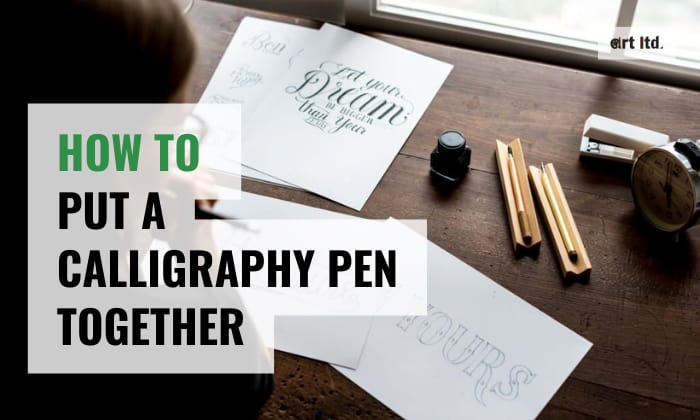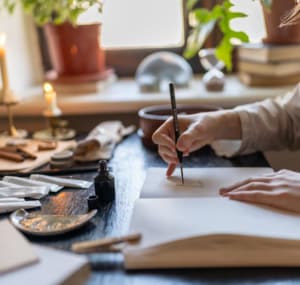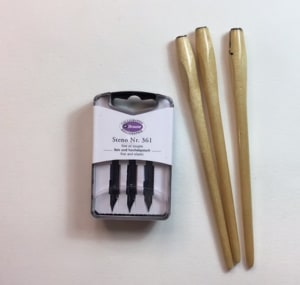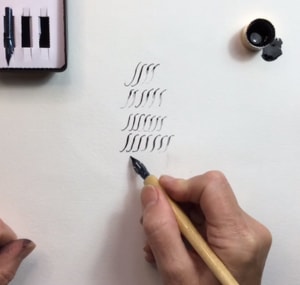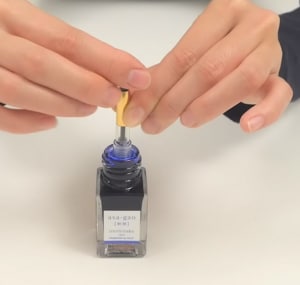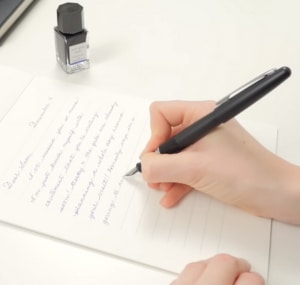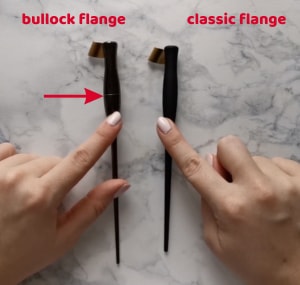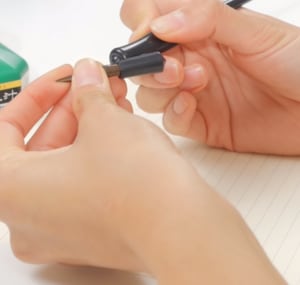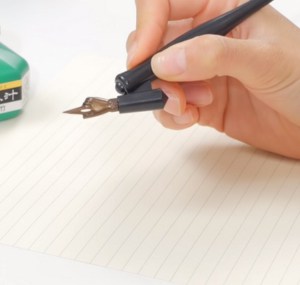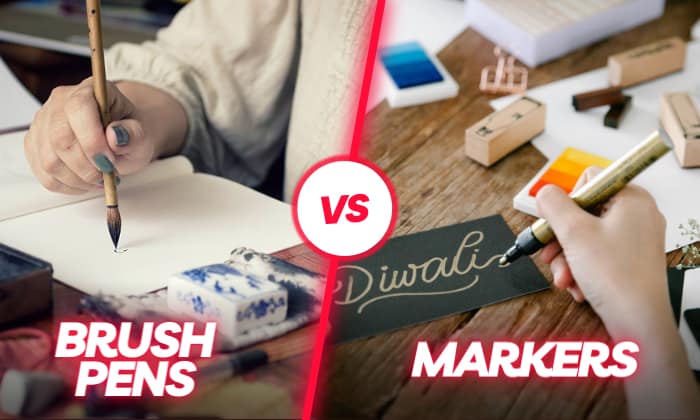Calligraphy is a writing style widely used in documents such as certifications and other formal settings. It’s not just a way of writing but a timeless form of art.
Typically, it requires you to use a calligraphy pen, and if you want to learn traditional calligraphy, one of the things that you have to master is knowing how to assemble a calligraphy pen.
This article will give you a complete guide on how to put a calligraphy pen together according to its type; we’ll also share some maintenance tips and more.
Table of Contents
Step-by-step to Put a Calligraphy Pen Together
There are three significant types of calligraphy pens, each with a different way to assemble:
- Dip Pen
- Fountain Pen
- Oblique Pen
Related: Fountain Pens vs Dip Pens
Let’s get to know each of them.
Dip pen
This is one of the oldest types of calligraphy pens. It is also among the simplest and most affordable of its kind. However, they do not have an ink reservoir, so it requires constant ink dipping.
These pens are typically designed to be disposable. For the most part, they are very easy to use and assemble.
What To Prepare
- Dip pen holder
- Dip pen nib
- Small brush
- Toothpaste
- Water
- Paper
- Paper towel
- Ink
Detailed Steps on How To Assemble a Dip Pen
Step 1. Get to know the basic parts.
- The holder
- There are three significant types of dip pen holders based on size and mount type, so make sure the pen holder and the nib are compatible.
- Standard Size Mount – for regular concave nibs (Ex. Speedball 9451 ).
- Crow Quill Mount – smaller and designed for nibs with rounded ends (Ex. Speedball 102 ).
- Dual slotted – has two mount options and can be used on both standard and crow quill nibs (Ex. Tachikawa T-40).
- The nib
- Can be pointed, broad, or rounded. Pointed nibs plus flexibility are the best combinations for calligraphy.
Alternatively, you can go for a dip pen in sets like a Manuscript Calligraphy pen, the Artist’s set, or a GC quill calligraphy pen set.
Step 2. Prepare and clean the nib.
- Remove the grease on the nib.
- Apply a pea-sized bead of toothpaste on a brush.
- Brush it lightly on the nib.
- Rinse it with water.
- Pat dry with a paper towel.
Step 3. Install the nib.
- Hold the dip pen holder firmly in an upright position, with the mount facing upward.
- Use your other hand to hold the nib and carefully slide it into the slot.
- Push the nib further until it fits snugly.
Step 4. Infuse it with ink and test.
- Submerge the nib into an ink bottle, but make sure the tip doesn’t touch the bottle’s bottom.
- Test it on paper.
Fountain pen
If you want a luxurious calligraphy writing experience, then this option is for you.
Moreover, contrary to the common belief that fountain pens are exorbitant, you can actually get pretty decent and cool fountain pen sets from 5 BELOW, Pennelli calligraphy pen set, or other low-cost arts and crafts stores.
What To Prepare
- Fountain pen of your choice
- Paper towel
- Vertical pen holder
- Paper
- Ink
Detailed Steps on How To Assemble a Fountain Pen
Step 1. Know the different types and learn the different parts.
- Here are the different fountain pen types and how to refill them.
- Cartridge – uses disposable insert-type ink cartridges.
- Eyedropper – requires an eyedropper to refill.
- Converter – has a removable syringe-like ink reservoir. Depending on the brand, it can also be converted into a cartridge type.
- Piston/Vacuum filler – has a built-in ink bladder.
- Nib types
- Similar to dip pens, fountain pens have three types of nibs. Moreover, for fountain pens, the broad type is more recommended for calligraphic writing.
Step 2. Assemble the barrel and grip section.
- Simply screw the grip section into the barrel.
- Clean the nib if needed.
- Put it in a vertical pen holder with nibs pointing down.
- Leave the pen for an hour to let the ink saturate the nib. You can skip this step for converter fountain pens, as they can be used right away.
Step 3. Check the ink flow.
- Scribble a few lines.
- If you get a constant ink flow, your fountain pen is ready for a calligraphy exercise.
- In case the ink doesn’t come out, try priming it. Some fountain pens with built-in reservoirs need priming to get a good ink flow.
- Priming is done by letting out a few drops of ink through the nib before completely sealing the grip section or by pressing the ink cartridge to force ink flow.
Oblique pen
This calligraphy pen type is another less expensive choice. They are also recommended for beginners. Its diagonal nib position can naturally enhance the thickness and angle of the strokes. Similar to dip pens, ink dipping in between strokes is necessary.
What To Prepare
- Oblique pen holder
- Oblique pen nib
- Paper
- Ink
Detailed Steps on How To Assemble an Oblique Pen
Step 1. Check what type of flange you have.
- There are two types of flanges.
- Adjusted or the classic flange—this variety has a fixed size and can only fit a particular nib. It can be a fixed concave or rounded flange.
- Adjustable or the bullock flange—this can fit different sizes of nibs and can be adjusted with a knob.
Step 2. Install the nib.
- Classic flange
- Insert the flange all the way into the circle at the end of the holder. Skip this step if the flange is already fixed to the holder.
- Pick up the nib so that it’s facing down.
- Hold the oblique pen holder with your other hand.
- Support the flange with your fingers.
- Gently slide the nib into the flange.
- Bullock flange
- Hold the nib in between your thumb and long finger.
- Insert it into the flange bracket. Support it with your thumb.
- Twist the knob or screw to fix the nib.
Step 3. Check if the nib is in the correct position.
- Its tips should be somewhere in the middle of the holder’s body.
- The nib should fit nicely and do not wobble.
- Nib – should be facing down.
- Breather – aligned at the center of the flange and is not covered.
Step 4. Ink and start writing.
- Dip the nib just right above the breather.
- Draw a few lines on paper to check the ink release.
Tips and Tricks
1. Tips for ensuring smooth assembly process
- When you put together a calligraphy pen nib reservoir, take note of the position and distance. Installing it 2mm from the tip is the safest baseline.
- Before you load a calligraphy pen with ink, double-check if the nib is firmly fitted. In the case of fountain pens, make sure the cartridge is installed properly.
2. Common mistakes to avoid
- Wrong nib selection. For example, not all fountain pens are suitable for calligraphy. So, you can’t just use any nib.
- Buying parts without checking compatibility. Before you set up a calligraphy pen, keep in mind that these pens have different variations across brands.
Maintenance Tips for Your Calligraphy Pen
1. Dip Pens and Oblique Pens
- Do not let water or ink sip into the pen holder. Corrosion can start as soon as moisture is accumulated in the pen and dried ink will form a sludge that causes the nib to get stuck and harder to remove.
- Practice removing the nibs and cleaning both the nib and the holder after every use.
- Always dry the parts before storing them.
2. Fountain Pens
- Clean your pen once in a while after every use and make an overall cleaning at least once a month. This will prevent ink from drying in the nib, which is the number one cause of clogging.
- To minimize the rate of ink evaporation, store your pens in an airtight container.
- Store spare nibs in a pill box or zip-lock pouches.
Benefits of Assembling a Calligraphy Pen Correctly
Assembling a calligraphy pen for the first time could be a daunting task but taking time to meticulously follow the instructions will give you lasting benefits.
This includes lower risk of leaking, good ink flow, prevention of nib damage. Overall, it helps you achieve that smooth calligraphy writing experience, saves you a lot of time and money, and makes your pen last longer at the same time.
Parts of a calligraphy pen
As an overview here is a summary of its parts.
| Type | Nibs | Variations |
| Dip Pens | Pointed and flexible | Standard
Crow Quill Dual Slotted |
| Fountain Pens | Broad and rigid | Cartridge
Eyedropper Converter Piston/Vacuum Filler |
| Oblique Pens | Pointed and flexible | Classic flange
Bullock flange |
Alternatives of Calligraphy Pen
The art of calligraphy is not confined to traditional calligraphy pens. Here are some alternatives that can give you equally satisfying outputs.
- Brush Pens
One thing that makes brush pens suitable for calligraphy is their flexible nibs that feel similar to when you write with calligraphy pens. This quality enables brush pens to produce various line thicknesses depending on the pressure applied.
The nibs can be made with natural or synthetic bristles and felt. The material quality often impacts the user experience and durability of the brush pen.
- Markers
Broad nib, tri-tip, dual-ended, name it and you will find it. With its wide range of tip types and sizes, there’s no doubt that it would make a good calligraphy pen alternative.
The best thing about markers is that they are readily available and budget-friendly.
Conclusion
Learning how to put a calligraphy pen together starts with knowing the different parts and their variations.
May it be a dip pen, fountain pen, or oblique pen, when you are already familiar with what you are dealing with, it would be easier for you to follow through.
If you find this process overwhelming, you can however start with ready-to-use calligraphy pens like the fine touch calligraphy pen set, brush pens, and markers.

Art has always been a part of my life; it influences my upbringing and later my career choice. For me, it is always a part of my parenting technique. So for whichever purpose that you come to art, you can start here with us.
